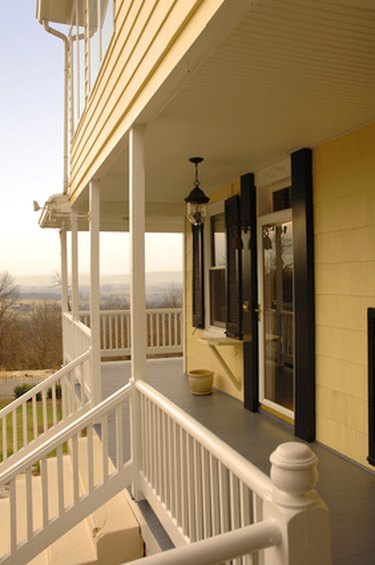Things You'll Need
Sketch pad
Measuring tools
Graph paper
Home design books
Remodeling magazines

A well-planned porch area can extend a home's living and entertaining area. Most families like to use a porch to sit, dine or watch TV during good weather. It's also a good place to remove boots and shoes during rainy or snowy weather. A porch can be designed to store specific items or cut firewood. The overall market value of a house should be enhanced with a good porch design. The roof line of the porch should complement the architectural style of the house, but it should also blend well with surrounding homes in the neighborhood.
Step 1
Purchase a sketch pad to begin the process of creating a porch design. Measure the existing home if the porch is to be added on so that all dimensions of the new porch will fit what's in place. Create a porch to harmonize with a home's design by planning the porch to look as if it's always been in place. Draw the house and porch on graph paper using one space of graph paper to represent 12 inches of real space.
Video of the Day
Step 2
Review home design books to envision the roof line and pitch of the porch roof that will fit the house. Sketch a porch with a 30-degree angle, for example. Draw the porch with a 45-degree angle next to see how the two drawings compare. Include all details in the drawings, such as overhangs and guttering, so the finished look will be easy to envision.
Step 3
Plan the porch's uppermost horizontal roof line to fit well with second-story windows. Sketch this porch roof line to fall right under the window sills, for example. Draw another version to make the highest part of the porch roof to fall a couple of feet below the window sills. Sketch the porch from various angles to review how it will look in relation to the overall house.
Step 4
Draw various columns and railings on a porch. Give the porch a less formal look by drawing railings all the way around. Sketch a more formal porch by planning columns with no railings every five or six feet. Don't include too many accessories in porch railings, unless the house is Victorian. Keep the lines relatively clutter free so that a future buyer will view the porch as appropriate for the structure.
Step 5
Draw steps in the front section of the porch, perhaps ascending to ground level right in front of the home's entrance door. Experiment with steps at either end of the porch as well if this provides needed access to a side yard. Create easy access to the porch area with walk-out double doors from living areas if this is appropriate for the house. Consider installing a sliding glass door to access the porch from the home's interior if the porch is on the back or side of a house.
Tip
Keep in mind that a roof line of the porch is cruicial for building an acceptable architectural style. Make sure the house and porch roof lines both harmonize on a given structure. Don't use a porch meant for a ranch house, for example, on a French colonial home.
Warning
Design a porch to be structurally sound, since almost any porch will weigh thousands of pounds. Consult with a building expert to configure spacing of beams and rafters in every regard. Support columns and methods of assembling the wood framing will ensure the porch will stand for decades. Plan to bolt the porch to the house framing, versus attaching by nails or screws, to ensure stability.
Video of the Day